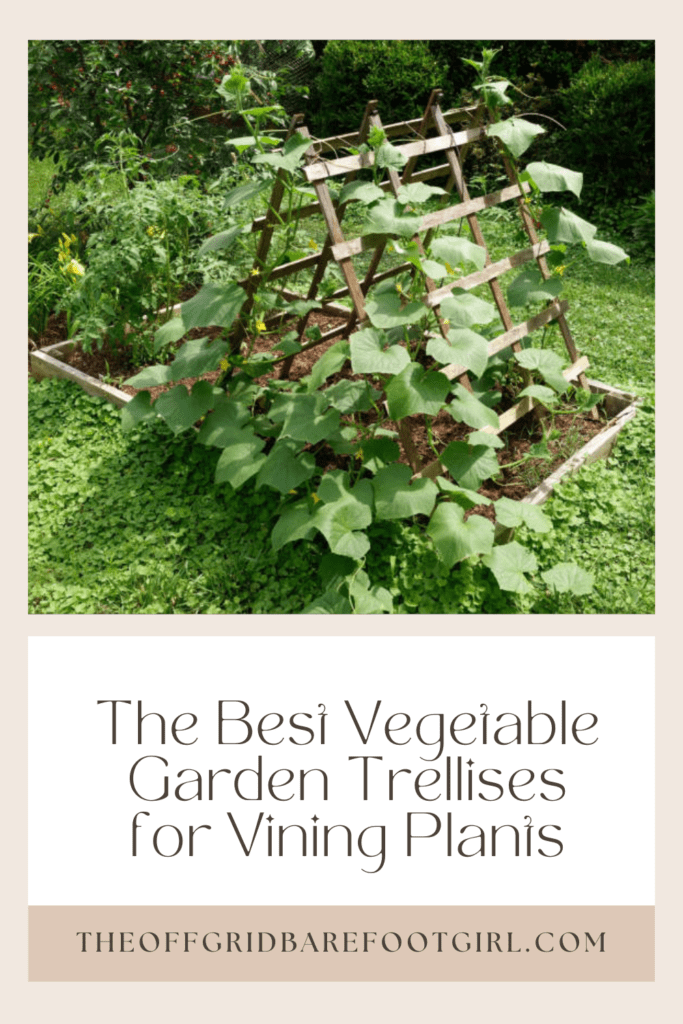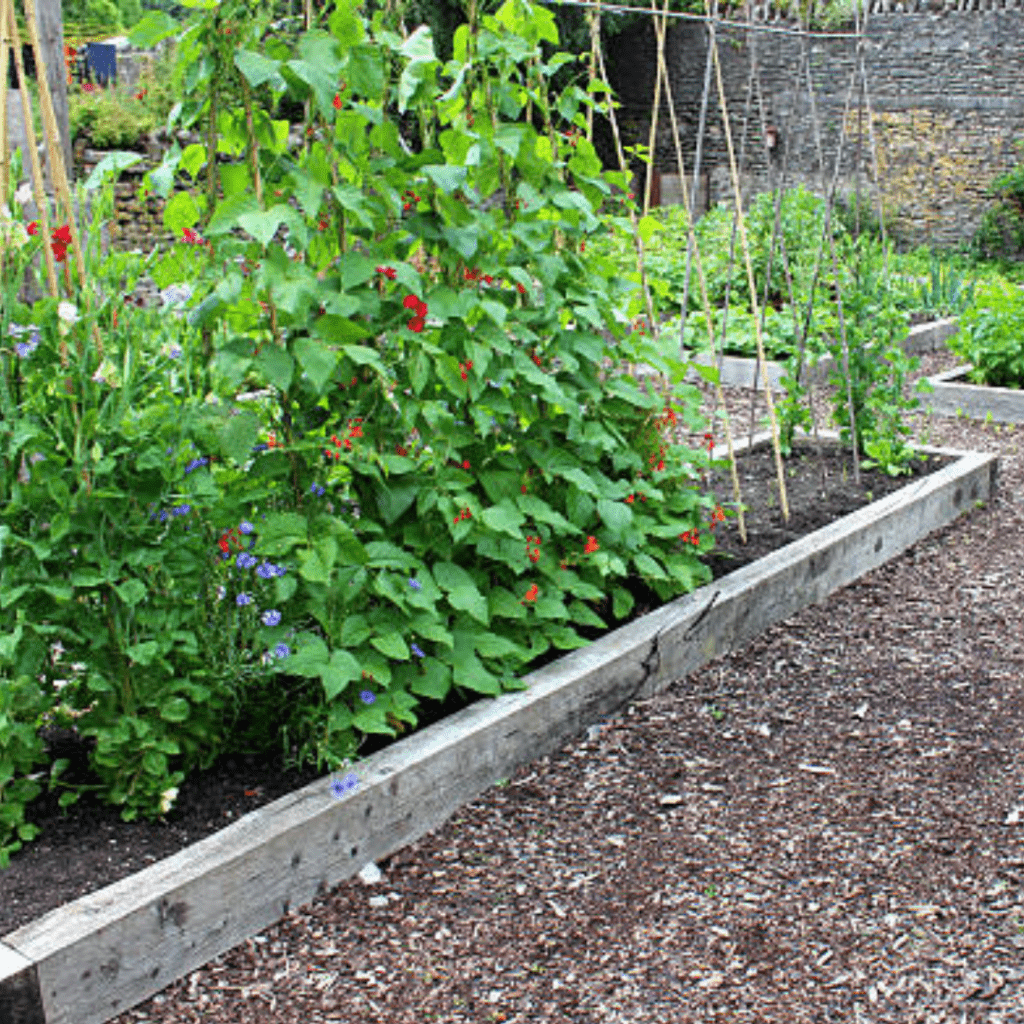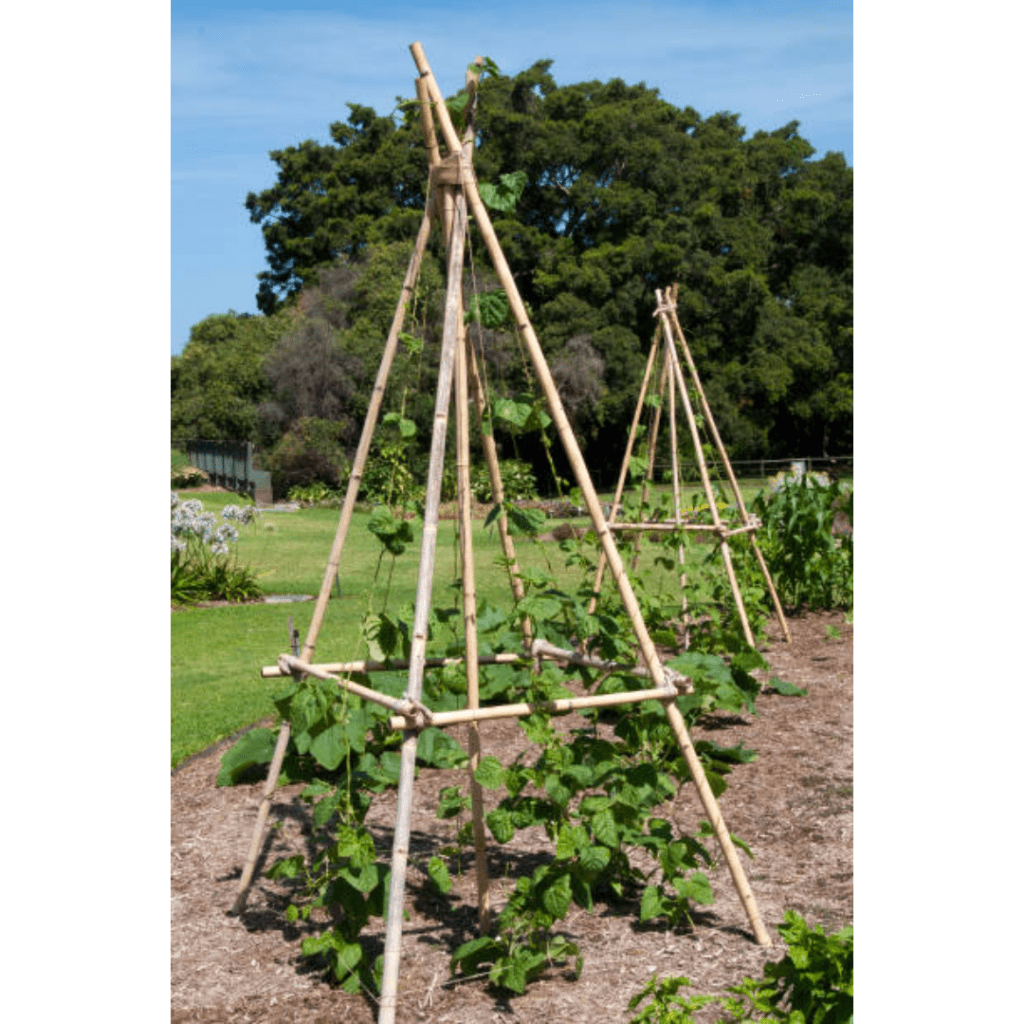Vegetable garden trellises.
Vegetable garden trellises are versatile and essential structures for gardeners looking to maximize their space and cultivate vining plants effectively. These trellises provide numerous benefits, such as optimizing vertical space, improving airflow and sunlight exposure, and facilitating easier maintenance and harvesting. However, choosing the right trellis for your specific vining plants requires careful consideration of factors like plant type, size, weight capacity, and material durability. In this article, I will explore the best vegetable garden trellises available and provide guidance on installation, maintenance, and plant training techniques to help you create a thriving trellis garden for your vining plants.
This is a pinnable post. Tap or hover over any image in this post to pin to your Pinterest Boards.

Introduction to Vegetable Garden Trellises
What Are Vegetable Garden Trellises?
Vegetable garden trellises are like the fairy godmothers of the plant world – they provide support and guidance for vining plants as they grow tall and reach for the sky. These trellises are structures made of various materials such as wood, metal, or even bamboo, designed to give vining plants a sturdy framework to cling onto.
Importance of Trellises In Vining Plant Cultivation
Trellises are essential for vining plants because they prevent them from sprawling all over the ground like a rebellious teenager’s messy bedroom. By keeping the plants off the ground, trellises help improve airflow around the leaves and increase exposure to sunlight, resulting in healthier and happier plants. Plus, they make your garden look organized and Instagram-worthy – because who doesn’t want their garden to be #goals?
Benefits of Using Trellises for Vining Plants

Vertical Space Optimization
If you have a small garden or limited space, trellises are your secret weapon. By training vining plants to grow upwards, trellises make the most out of your vertical space, allowing you to have a garden that’s not only beautiful, but also efficient. It’s like having a green wall that doesn’t require a fancy irrigation system or a green thumb.
Improved Airflow and Sunlight Exposure
Plants need two things to thrive: air and sunlight. Trellises help with both. By lifting vining plants off the ground, trellises increase airflow, reducing the risk of diseases caused by stagnant moisture. They also ensure that every leaf gets its fair share of sunlight, resulting in happier plants that produce more delicious veggies for you to devour.
Easier Harvesting and Maintenance
Trellises are like personal trainers for your plants. They help you keep things in order, making it easier to access and harvest your precious produce. No more rummaging through tangled vines or accidentally squishing your fragile tomatoes. Plus, trellises make it a breeze to prune, water, and care for your plants, saving you time and effort.
Factors to Consider when Choosing a Vegetable Garden Trellis
Types of Vining Plants
Before you embark on your trellis quest, consider the specific needs of your vining plants. Different plants have different growth habits. Some are lightweight and delicate, while others are more robust and heavy. Understanding the nature of your plants will help you choose a trellis that can handle their unique personalities.
Size and Weight Capacity
Size matters when it comes to trellises. Make sure to pick a trellis that matches the height and width requirements of your vining plants. Also, consider the weight capacity of the trellis. You don’t want your plants to outgrow their support and come crashing down!
Material and Durability
Trellises come in various materials, each with its own pros and cons. Wooden trellises are sturdy and blend well with the natural environment, but they might require maintenance over time. Metal trellises are durable and can withstand the elements, but they might get uncomfortably hot like a metal park bench in the middle of summer. Choose a material that suits your needs and can withstand the demands of your vining plants.
Top 5 Recommended Trellises for Vining Plants
1. Foldable Trellisese
The foldable trellises allow you to plant on two sides of the trellis allowing the vining plants to reach and meet at the top of the trellis, sometimes even climbing over it. Foldable trellises are easy to store at the end of the season and take up little storage space!
2. Zhongma Metal Garden Trellises
The Zhongma metal garden trellises come in a pack of two and are 77.2 inches tall and 16 inches wide and stake in the ground for vining plants to climb. These are very gorgeous trellises that provide a ton of vertical growing spaces, especially along fences as these trellises are flat! They make beautiful walls and dividers in the garden.
3. Garden Obelisk Trellises
The garden obelisks are great for potted vining plants or as beautiful centerpieces in the garden that allow pole beans or other vining plants to steal the spotlight in the garden. Garden obelisk trellises add a touch of whimsy to the garden and they come in a variety of colors!
4. Large Bean Towers
Grow your pole beans nice and high with large bean towers that take up little space in the garden with dimensions of only 41 x 15 x 2 inches. These large bean towers can help you grow a ton of beans in little spaces!
5. Expandable Pea Trellises
Having an expandable pea trellis in your garden can help you grow a ton of peas or other vining plants vertically. These trellises are 9 feet long, helping you grow a nice wall of vining plants and produce a lot of homegrown food!
How to Install and Maintain a Vegetable Garden Trellis

Preparing the Garden Space
Before installing a trellis for your vining plants, it’s important to prepare your garden space properly. Start by clearing away any weeds or existing vegetation in the area where you plan to place the trellis. This will ensure that your plants have ample space to grow and won’t compete with unwanted plant species.
Setting Up the Trellis Structure
Once you have cleared the area, it’s time to set up the trellis structure. Most trellises come with instructions, so make sure to read them carefully. Identify the ideal location for your trellis based on factors such as sunlight, wind exposure, and proximity to other plants. Place the trellis firmly in the ground, ensuring that it is stable and secure.
Properly Anchoring the Trellis
To prevent your trellis from toppling over or shifting during strong winds, it’s crucial to anchor it properly. Use stakes or hooks to secure the trellis to the ground or nearby structures, such as fences or walls. This will provide added stability and support for your vining plants as they grow.
Maintenance Tips for Long-Term Use
To ensure the longevity of your vegetable garden trellis, regular maintenance is key. Inspect the trellis periodically for any signs of damage or wear, and make any necessary repairs promptly. Additionally, during the growing season, monitor your vining plants for any signs of overgrowth or entanglement. Prune and train them as needed to keep them growing in the desired direction and prevent overcrowding.
Tips and Techniques for Training Vining Plants on Trellises
Understanding Vining Plant Growth Habits
Before you start training your vining plants on a trellis, it’s important to understand their natural growth habits. Some vining plants, like cucumbers and squash, tend to grow horizontally, while others, like peas and beans, tend to grow vertically. This knowledge will help you determine the best trellis design and training methods for each specific plant.
Pruning and Training Methods
Pruning and training are essential techniques for shaping your vining plants on a trellis. Regularly remove any side shoots or suckers that may divert energy away from the main stems and limit vertical growth. As your plants grow, gently guide the main stems along the trellis, using plant ties or soft twine to secure them if necessary. This will encourage upward growth and prevent tangling or overcrowding.
Using Plant Ties and Supports
Plant ties and supports can be incredibly helpful when training vining plants on a trellis. Use soft twine or flexible plant ties to secure the stems to the trellis, allowing them to grow vertically without straining or breaking. You can also use additional support structures, such as trellis netting or mesh, to provide extra stability and promote even growth.
Troubleshooting Common Issues with Trellises in Vegetable Gardens
Trellis Stability and Reinforcement
One common issue with trellises in vegetable gardens is stability. Strong winds or heavy fruit loads can put a strain on the trellis structure and potentially cause it to collapse. To reinforce your trellis, consider using thicker stakes or larger anchor hooks. Additionally, regularly inspect the trellis for any signs of weakness or instability, and make necessary repairs or adjustments as needed.
Dealing with Pests and Diseases
Pests and diseases can also pose challenges for trellised vining plants. Keep a close eye on your plants for any signs of infestation or disease, such as chewed leaves or wilting. Implement preventative measures, such as applying organic pest control methods or using disease-resistant plant varieties. Promptly address any issues to prevent them from spreading to neighboring plants.
Addressing Overcrowding and Competition
Vegetable garden trellises can be a double-edged sword when it comes to overcrowding. While trellises help maximize vertical growing space, they can also lead to overcrowding if plants are not spaced adequately. Regularly thin out excess foliage to ensure that each plant has enough room to grow and receive sufficient sunlight. This will reduce competition for resources and promote healthier overall growth.
Fun and Creative Trellis Ideas for Your Vegetable Garden
Upcycling Everyday Items as Trellises
Who said trellises have to be boring? Get creative in your garden by upcycling everyday items as trellises. Old ladders, bicycle wheels, or even salvaged wood can be transformed into unique and eye-catching trellis structures. Not only will this add a touch of personality to your vegetable garden, but it’s also an environmentally friendly way to repurpose items that would otherwise go to waste.
Incorporating Decorative Elements into Your Trellis
Why settle for a plain trellis when you can make it a stunning focal point in your garden? Consider incorporating decorative elements into your trellis design, such as colorful ceramic tiles, hanging lanterns, or ornamental metalwork. These additions will not only enhance the aesthetic appeal of your garden, but also showcase your personal style and creativity.
Adding a Touch of Whimsy to Your Garden with Unique Trellis Designs
Don’t be afraid to think outside the box when it comes to trellis designs. Let your imagination run wild and create trellises that reflect your unique personality and interests. Whether it’s a trellis shaped like a giant sunflower or one that resembles a miniature arbor, these whimsical designs will bring a sense of playfulness and joy to your vegetable garden.
Conclusion
In conclusion, incorporating vegetable garden trellises into your gardening practice can significantly enhance the growth and productivity of your vining plants. By carefully selecting the right trellis, installing it properly, and employing effective training techniques, you can create an efficient and visually appealing garden space. Whether you have limited space or simply want to optimize your garden’s potential, trellises offer a practical solution. Embrace the benefits of trellis gardening and enjoy an abundant harvest of healthy, thriving vining plants!

Frequently Asked Questions
1. Can I use a trellis for any type of vining plant?
Yes, trellises can be used for a wide variety of vining plants, including vegetables like tomatoes, cucumbers, and beans, as well as flowering vines like morning glories and sweet peas. However, it’s essential to consider the specific needs and growth habits of each plant to select an appropriate trellis.
2. How do I choose the right size trellis for my vining plants?
When selecting a trellis, consider the mature size and weight of your vining plants. Look for trellises with sufficient height and width to accommodate the growth and spreading of your plants. Additionally, ensure that the trellis is strong enough to support the weight of the plants when fully grown.
3. How do I maintain and clean my vegetable garden trellis?
Regular maintenance of your vegetable garden trellis is essential for its longevity and performance. Inspect the trellis periodically to identify any damage or signs of wear. Clean the trellis by gently brushing away debris or using a mild soap solution and water if necessary. Additionally, consider removing any plant residue or dead vines to prevent the buildup of pests or diseases.
4. Can I reuse my trellis for different vining plants?
Yes, in most cases, trellises can be reused for different vining plants. However, it’s important to clean and sanitize the trellis between plantings to prevent the spread of diseases. Additionally, make sure to adjust the trellis’s height, spacing, and supports as per the requirements of the new plants you are growing.
Summary
I hope I have inspired you to use vegetable garden trellises in your garden with these tips and products.
If you were encouraged by this post, I invite you to check out my FREE Printables Page for fun free printables, planners, and charts.
ENTER MY FREE Printables Page HERE
Here are some more of my gardening inspiration posts to check out!
How to Grow a Prepper Garden to Survive and Thrive
The Best Garden Tools You Need for a Productive Season
Fastest Growing Vegetables for Your Survival Garden
How to Grow Marigolds As Pest Control In Your Vegetable Garden
Must-Have Tools for a Successful Balcony Vegetable Garden
How to Effectively Combat Powdery Mildew in Your Garden
The Best Tips for Organic Gardening
How to Release Ladybugs In Your Garden for Organic Pest Control
The Best Garden Snail Control Strategies
The Best Spring Vegetables to Grow in Your Garden
Seed Starter Mix: How To Make Your Organic Seed Starter Mix At Home
How to Grow a Productive Canning Garden
How to Plant and Grow a Salsa Garden
Easiest Heirloom Vegetable Seeds to Grow Now
How to Use the Hand Twist Claw Tiller: Tackling Tough Soil
Planning Your Garden: How to Plan a Vegetable Garden: Expert Green Thumb Tips!
Winterizing the Garden: How to Winterize Your Vegetable Garden: Step-by-Step Checklist
Mulching the Garden: How to Make Leaf Litter Mulch
Grow a Pumpkin Patch: How to Grow a Pumpkin Patch in Your Backyard
How to Grow a Fall Garden: 9 Best Fall Crops
Clever Ways to Incorporate Indoor Composting into Your Home
How to Start Composting for the Garden: A Step-by-Step Guide
The Ultimate Guide to Composting in Your Suburban Backyard
Why I Built A Survival Garden in My Backyard
16 Best Medicinal Herbs to Grow in Your Garden Now
Blessings,
The Off Grid Barefoot Girl




